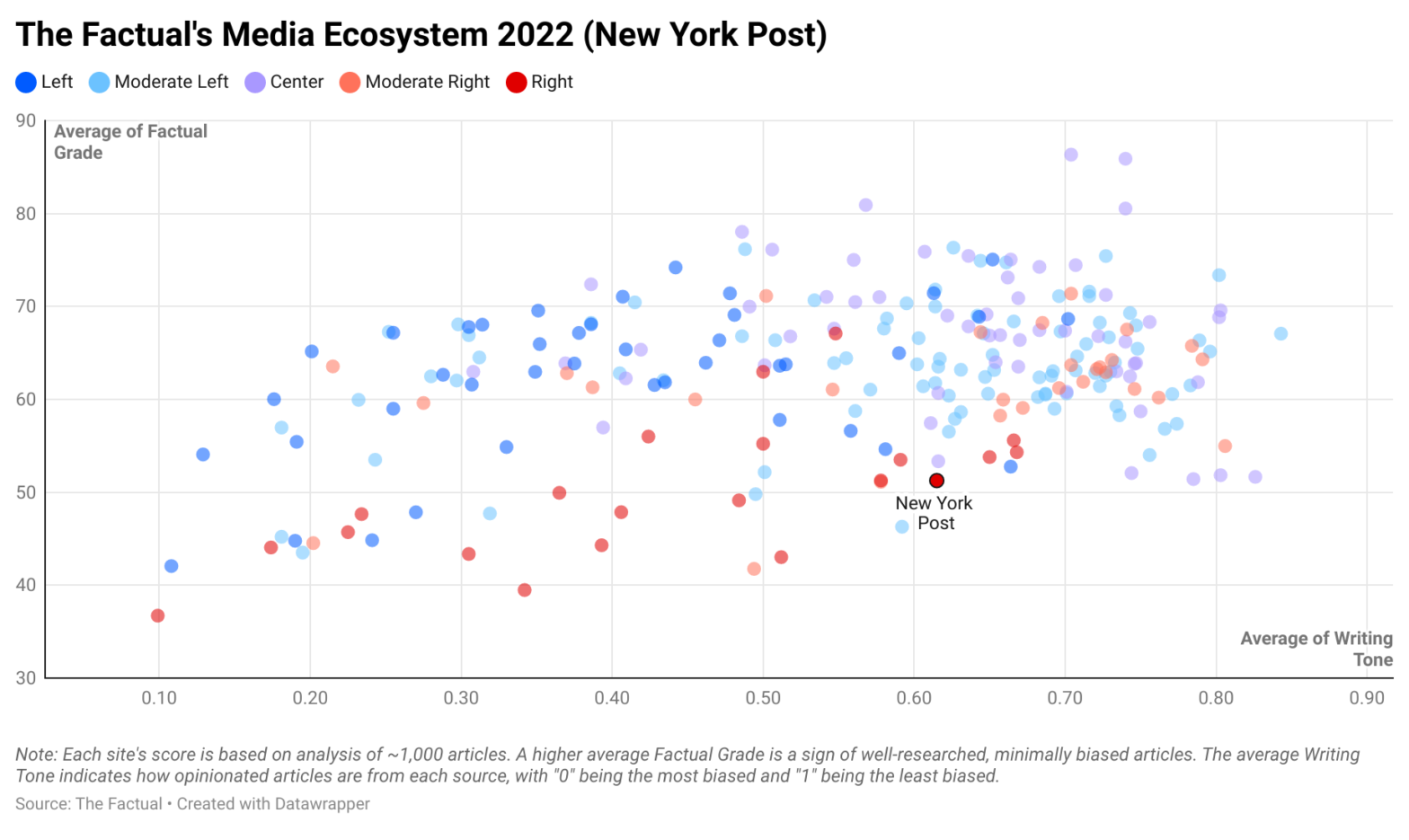A Pace University survey in 2004 found the New York Post to be the city’s least-credible major news source. A tabloid-style paper, it has a reputation for sensationalized headlines, questionable journalistic practices, conservative bias, and influence from its ownership. Today, however, it remains the sixth most widely circulated newspaper in the country. So, how credible is the New York Post, and how biased is it?
How Does The Factual Rate News Sources?
The Factual analyzes more than 10,000 news stories every day to help readers find the most informative, least-biased articles. Our news-rating algorithm scores each article along four metrics: (1) cited sources and quotes, (2) publication history, (3) writing tone, and (4) author expertise. These scores combine in a weighted average we call a Factual Grade, which ranges from 0–100%. (See our How It Works page to learn more about our algorithm.)
For this study, we analyzed ~1,000 articles each from 240 news sources. The average Factual Grade for the entire dataset was 62.5%. Based on these averages, we can compare the performance of news sites across the media ecosystem. The entire dataset can be explored in greater detail here.
How Factual Is the New York Post?
The New York Post scored an average Factual Grade of 51.3%, placing it in the tenth percentile of our dataset. These low overall scores are partially due to low-quality sourcing, a lack of author expertise, and sensationalized writing and headlines. Most articles only have intermittent links to supporting evidence. Many of those links point back to other internal articles, suggesting limited diversity in sourcing. The Post’s tabloid style means some authors write on many different topics, leading to low overall scores for author expertise. The site’s approach to driving traffic involves the use of sensationalized headlines and text.
Like any news source, scores for articles from the New York Post vary widely because some articles are better sourced or less opinionated than others. For example, some scored 70% or above, while others scored below 40%.
How Opinionated Is the New York Post?
One of the metrics The Factual uses is the Writing Tone, which measures how opinionated the writing is in an article. For this metric, the algorithm looks for signs of subjective commentary (e.g., first person pronouns and unnecessary adverbs), as well as the emotional nature of selected words, and sees how prevalent they are for a given length of text. More neutral text receives higher ratings, with “0” being the most opinionated and “1” being the most neutral.
The New York Post had an average Writing Tone score of 0.62, placing it in the 50th percentile in our dataset for this metric. This suggests that articles from the site are moderately opinionated in tone on average. This can be seen in headlines such as “Good riddance to Dr. Fauci” and “Democrats keep giving the US economy poisonous ‘medicine’.”
What Is the New York Post’s Political Bias?
The Factual classifies news sites by political bias as either Left, Moderate Left, Center, Moderate Right, or Right. This classification comes from third-party assessments from media bias organizations such as All Sides and Media Bias/Fact Check (MBFC). Based on this data, The Factual assigns the New York Post a Moderate Right bias.
AllSides rates the New York Post as “Lean Right” based on an editorial review, community feedback, and blind bias surveys. The latest editorial review, in January 2021, found a mix of biased and unbiased reporting, as well as an overall approach to story selection that favors right-leaning perspectives, though not to an extreme degree. Overall, AllSides found the paper “to be biased toward clicks, not necessarily always left or right.”
MBFC rates the paper as having a “Right-Center” bias due to a tendency to publish articles that favor the right. They note that the paper has endorsed every Republican candidate for president since 1980, abstaining in 2016, but endorsing then-president Trump in 2020. MBFC gives the Post a “Mixed” score for factual reporting, based on several failed fact-checks.
Who Owns the New York Post?
The family of Rupert Murdoch owns the New York Post through the media group News Corp, which also owns Fox News, a number of UK tabloids, and numerous publications in Australia. Murdoch’s ownership has been repeatedly criticized for influencing the publication, including driving its shift toward sensationalism and imparting a conservative bias to its reporting. The paper is reportedly a favorite of former president Trump, and Trump and Murdoch have a close relationship. However, the Post was by no means in lockstep with the former president. For example, it ran the frontpage headline “Stop the Insanity: You lost the election – here’s how to save your legacy” in December 2020.
Please check your email for instructions to ensure that the newsletter arrives in your inbox tomorrow.
Why Does It Matter?
News articles always have bias because all authors use some frame of reference when they write a story. Political bias ratings are helpful in understanding this framing. However, it can be more beneficial to know how factual an article is based on quantifiable metrics that can be seen across the media ecosystem, from cited evidence, to author expertise, to the writing tone. This is what The Factual ascertains.
Reading several, highly rated articles from across the political spectrum helps counter the bias of any news source or story. To have the day’s most factual news stories delivered to your inbox every morning, subscribe to our daily newsletter.
This article was updated on September 21, 2021 to reflect new data.

